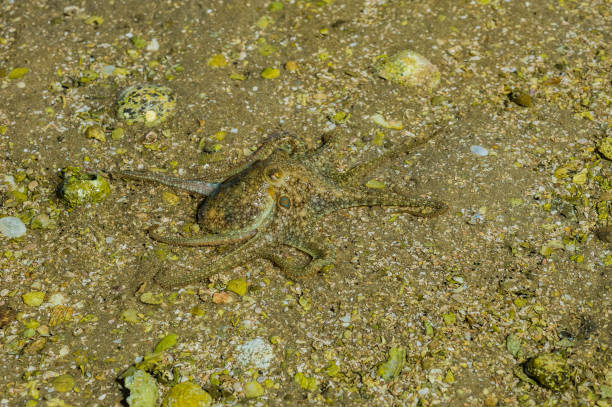ANIMAL: California Two-Spot Octopus Octopus bimaculoides Type of Animal: Octopus Habitat: Intertidal/subtidal zone up to 70 ft deep-reefs, canyon ledges, small caves for denning, holes, crevices, abandoned pipes, debris for hiding, pilings, shallow sandy areas w/ rocks/crevices, prefers temps of 65-72 F Location(s): C California to N Baja California Appearance: 2 bright blue spots resembling eyes on either side of body, most often mottled brown or gray w/ yellow splotches but can change color, sometimes has orangish tone, 8 tentacles Food/Diet: Snails, limpets, bivalves, black abalone, crabs, amphipods, shrimp, crayfish, fish Status in Wild: Stable Lifestyle: Solitary Additional Info: Called: Male: Cock Female: Hen Young: Paralarva Group: Solitary Mantle Size: 7 in Gestation: 2-7 months Life Span: 1-2 years Arm Length: 2 ft Body Length: 2 ft Weight: 4.4-8.8 lbs Main predators are moray eels, scorpionfish, pinnipeds, California sheephead, kelp bass, cabezon, & leopard sharks. They only mate once in a lifetime. Males die soon after mating & females die after eggs hatch. Female guards 20,000-150,000 eggs for 2-7 months. After hatching, paralarvae remain at bottom. Active at night (nocturnal). Get name due to false spots under eyes. Also called Twin-Spot Octopus, Bimac Octopus, & Bimac. After eggs hatch, paralarvae drift w/ tide before settling on ground. Reach maturity at 1-2 years old. Capture prey w/ tentacles using suckers to hold on prey while moving it towards beak/radula. Beak tears soft tissue & radula scrapes meat into shreds for eating. Radula pierces thick shells & injects neurotoxic venom. These octopus occasionally utilized as food source. Most often utilize tentacles when moving. Fun Fact(s): Most popular defense mechanisms are fleeing from predators, changing color, releasing ink, making itself look bigger, camouflage, & using tentacles to fight them. Sometimes lose arms when fighting w/ predators but can regenerate them. Like many octopi, they can change color/texture when responding to different stimuli, such as surroundings, hunting, predators etc. These octopi are very curious & friendly. Often considered best octopus to keep as pet but not for beginner aquarists. One of most popular octopi to keep as pets. These animals are highly intelligent, even finding ways to take lids off aquariums. While venom deadly to prey, it’s very mild to humans & predators (all octopus have venom of varying degrees).
